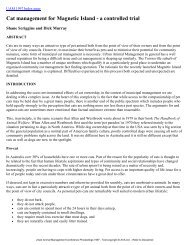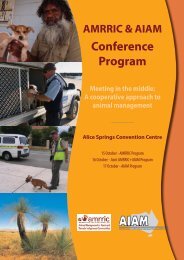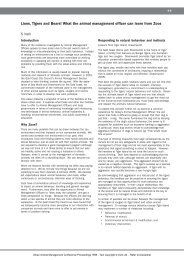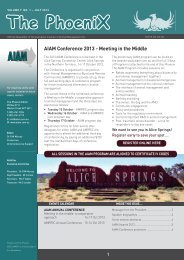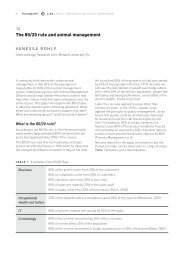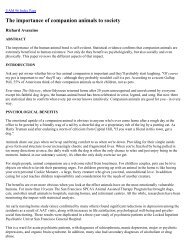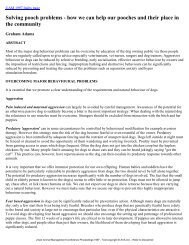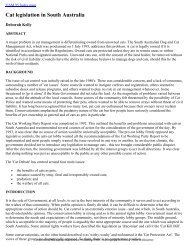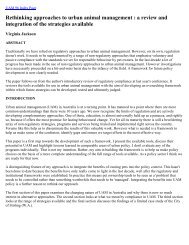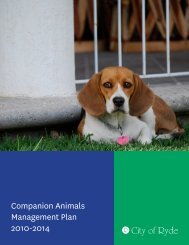Proceedings OF ThE - Australian Institute of Animal Management Inc
Proceedings OF ThE - Australian Institute of Animal Management Inc
Proceedings OF ThE - Australian Institute of Animal Management Inc
You also want an ePaper? Increase the reach of your titles
YUMPU automatically turns print PDFs into web optimized ePapers that Google loves.
26 <strong>Proceedings</strong> 2012<br />
AIAM Annual Conference on <strong>Animal</strong> <strong>Management</strong><br />
to baby animals, and many wild pups or fawns or piglets<br />
must have been brought back alive by hunting parties.<br />
In these above senses, man has probably always been<br />
an incipient cultivator and domesticator. (p 97, his<br />
emphasis).<br />
Braidwood and his colleague Richard Adams saw<br />
this early phase as part <strong>of</strong> a wave <strong>of</strong> experimentation,<br />
which included the invention <strong>of</strong> the new tools which<br />
appear in the archaeological record. There are<br />
also signs <strong>of</strong> a tendency to settle down in more<br />
permanent camp sites, but caves were still inhabited<br />
at the beginning <strong>of</strong> this era.<br />
Surely, if the food collecting era is a logical<br />
preliminary to food producing, then the invention <strong>of</strong><br />
food storing must be a corollary <strong>of</strong> food collecting?<br />
Inventing food storing might not have appeared as<br />
dramatically in the archaeological record as did the<br />
food producing revolution but it would have been<br />
a major breakthrough in the human struggle for<br />
survival.<br />
In nature, food is in abundance. This is by definition<br />
because, otherwise, there could be no food chain.<br />
There is more game on the Serengeti, more fruit in<br />
the trees, more grains on the grasses than animals<br />
can eat. Otherwise none <strong>of</strong> these things could exist.<br />
There is much evidence that our forebears luxuriated<br />
in natural excess: the piles <strong>of</strong> bones <strong>of</strong> mammoths<br />
and other herbivores attest to the wasteful practices<br />
<strong>of</strong> hunters in the distant past. Modern land-fills<br />
witness the situation today. Every gardener knows<br />
the chore <strong>of</strong> cleaning up fruit fallen from a tree.<br />
In Papua New Guinea I have seen crowds <strong>of</strong> boys<br />
satiated with mangoes make hardly a dent in the fruit<br />
piling under the tree. Modern day experiments have<br />
shown that food gatherers with primitive stone and<br />
bone sickles can quickly and easily harvest quantities<br />
<strong>of</strong> grain from wild grasses.<br />
There is ample food for animals including people.<br />
The problem lies in its seasonality. The lion fattening<br />
royally on the Serengeti Plain in the wet season<br />
becomes a fly infested bag <strong>of</strong> bones in the dry<br />
season. Birthing cycles have evolved to fit with the<br />
seasons <strong>of</strong> plenty. The survival <strong>of</strong> an animal which<br />
can store food, even if for only a short period, is<br />
greatly advantaged. The storing <strong>of</strong> varieties <strong>of</strong> food<br />
is a necessary step from hunting and gathering<br />
towards collecting food.<br />
The foods first stored in our ancestors’ caves<br />
probably were dried fruits and berries, dried meats,<br />
grains, tubers and roots. The food stored must be<br />
ventilated, otherwise it will not keep or may become<br />
toxic due to fungus. The food therefore would be<br />
accessible to vermin. Our cave dwelling ancestors<br />
could not have stored food unless dogs and cats<br />
were already living in the caves and keeping vermin<br />
in check. The storage <strong>of</strong> food by people further<br />
benefited the dogs and cats in the evolving complex.<br />
Therefore people, dogs and cats became part <strong>of</strong><br />
each other’s culture and, I argue, have remained so.<br />
Theirs were the paws that insensibly, but critically,<br />
shaped human affairs to allow the most important<br />
revolution to occur that our species had so far<br />
experienced: the move to food production and,<br />
eventually, urbanisation.<br />
And this is why the life <strong>of</strong> an <strong>Animal</strong> Manager is<br />
complicated by the subjective relationship people<br />
have with their dogs and cats. It is human nature<br />
to associate with dogs and cats, because we coevolved,<br />
just as it is human nature to groom each<br />
other because <strong>of</strong> our primate past.<br />
Tails <strong>of</strong> the city<br />
Does all this speculation amount to a hill <strong>of</strong> beans?<br />
I think so because the human world is becoming a<br />
city, and this presents a marvelous opportunity for<br />
creative <strong>Animal</strong> Managers.<br />
Because you have your feet on the ground, you know<br />
what is going on. That knowledge is most productive<br />
if it is put in context. We all need to read outside the<br />
square. Reading gives us the confidence to influence<br />
public policy makers who persist in seeing dogs<br />
and cats as objects. If urban animal management<br />
can see beyond “responsible pet ownership” and<br />
instead encourage (for example) “careful keeping<br />
<strong>of</strong> animals”, it may lose some <strong>of</strong> its adversarial<br />
image and instead appear positively normal. <strong>Animal</strong><br />
Managers have to carry out policies which have a<br />
strong odour <strong>of</strong> prohibition. How do you prohibit a<br />
relationship which is part <strong>of</strong> our nature?<br />
In Welcome to the Urban Revolution, Jeb Brugmann<br />
(2009) reminds us that half the world is now a city,<br />
with 3.5 billion people living in it. Soon there will be<br />
5 billion city dwellers. If my naturalistic argument is<br />
correct, as we crowd together until our population<br />
plateaus at 9 billion, we must continue to associate<br />
with the dog and cat to maintain sane, healthy<br />
communities.<br />
Some ideas<br />
I have to thank my youngest daughter, Gillian Paxton<br />
(2012) for guiding me to some new discourses on<br />
cities: Living Cities, Natureculture, and Cosmopolitics.<br />
These are names you may hear a lot in the coming<br />
years. The ideas behind them are not new, but<br />
the names link the ideas to some very powerful<br />
discourses in the social sciences. I also thank Tina<br />
Bloom (2011), who helped me scan the current<br />
social discourse on companion animal keeping. Tina<br />
is a psychologist working in a maximum security<br />
prison and exploring the use <strong>of</strong> animal assisted<br />
rehabilitation <strong>of</strong> troubled individuals.



